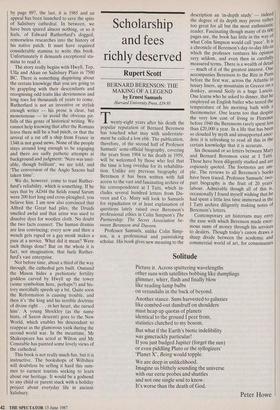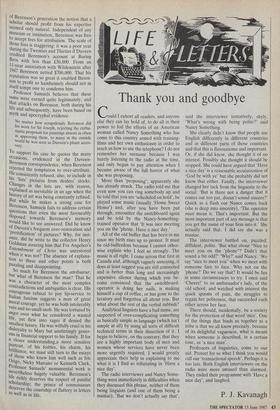Scholarship and fees richly deserved
Rupert Scott
BERNARD BERENSON: THE MAKING OF A LEGEND by Ernest Samuels
Harvard University Press, £19.95
Twenty-eight years after his death the popular reputation of Bernard Berenson has touched what may with understate- ment be called a low ebb. The publication, therefore, of the second half of Professor Samuels' semi-official biography, covering the years from 1904 to his death in 1959, will be welcomed by those who feel that the time is long overdue for its rehabilita- tion. Unlike any previous biography of Berenson it has been written with full access to the vast and fascinating archive of his correspondence at I Tatti, which in- cludes several hundred letters from Du- veen and Co. Many will look to Samuels for repudiation or at least explanation of questions lately raised over Berenson's professional ethics in Colin Simpson's The Partnership: The Secret Association be- tween Berenson and Duveen.
Professor Samuels, unlike Colin Simp- son, is a professional and painstaking scholar. His book gives new meaning to the description an 'in-depth study'
— indeed the degree of its depth may prove rather too great for all but the most enthusiastic reader. Fascinating though many of its 600 pages are, the book has little in the way of what Colin Simpson would call 'pace'. It is a chronicle of Berenson's day-to-day life>in which the professor ventures his opinion very seldom, and even then in carefully measured terms. There is a wealth of detail — much of it of the greatest interest. One accompanies Berenson to the Ritz in Pans before the first war, across the Atlantic in luxury liners, up mountains in Greece on a donkey, around Sicily in a huge Lancia. One learns who he asked to dinner, that he employed an English butler who tested the temperature of his morning bath with a thermometer. One learns too that despite the very low cost of living in Florence before 1940 the Berensons rarely spent less than £20,000 a year. In a life that has been so clouded by myth and unsupported anec- dote it is refreshing to read all this in the certain knowledge that it is accurate.
Six thousand or so letters between Mary and Bernard Berenson exist at I Tatti. These have been diligently studied and are copiously quoted. The footnotes are am- ple. The reviews to all Berenson's books have been traced. Professor Samuels' two- part biography is the fruit of 20 years' labour. Admirable though all of this is, occasionally I found myself wishing that he had spent a little less time immersed in the I Tatti archive diligently making notes of Berenson's letters.
Contemporary art historians may envy the ease with which Berenson made enor- mous sums of money through his services to dealers. Though today's canon draws a sharp divide between the academic and commercial world of art, for connoisseurs of Berenson's generation the notion that a scholar should profit from his expertise seemed only natural. Independent of any museum or institution, Berenson was free to accept fees for attribution. The scale of those fees is staggering: it was a poor year during the Twenties and Thirties if Duveen credited Berenson's account at Baring Bros with less than £30,000. From an 11-year association with Wildenstein after 1947 Berenson netted $700,000. That his reputation was so great it enabled Beren- son to profit so handsomely should not in itself tempt one to condemn him. Professor Samuels believes that these sums were earned quite legitimately, and that attacks on Berenson, both during his life and subsequently, have been based on myth and apocryphal evidence.
No matter how scrupulously Berenson did his work for Sir Joseph, rejecting the enthu- siastic proposals for paintings almost as often as approving them, to many in the outside
world he was seen as Duveen's pliant acces- sory,
To support his case he quotes the many occasions, evidenced in the Duveen- Berenson correspondence, when Berenson rejected the temptation to over-attribute. He consistently refused, also, to include in his 'lists' pictures from dealers' stocks. Changes in the lists are, with reason, explained as inevitable in an age when the history of art was being constantly refined. But while he makes a strong case for Berenson, Samuels fails to address certain questions that even the most favourably disposed towards Berenson's memory would like to see answered. Did he know of Duveen's frequent over-restoration and `prettification' of pictures? Why, for inst- ance, did he write to the collector Henry Goldman assuring him that Fra Angelico's Entombment of Christ was unrestored when it was not? The absence of explana- tion to these and other points is both puzzling and disappointing. So much for Berenson the attributeur, but what of Berenson the man? That he was a character of the most complex contradictions and ambiguities is clear. His courageous refusal to pay lip-service to Italian fascism suggests a man of great moral courage, yet he was both intolerably vain and no small snob. He was tortured by angst over what he considered a wasted life, yet flew into rages if denied the smallest luxury. He was wilfully cruel in his disloyalty to Mary but unstintingly gener- ous in financial support to his family. If for a closer understanding,a more sensitive Portrait, of his foibles, his charm, his brilliance, we must still turn to the essays of those who knew him well such as Iris Origo, Nicky Mariano or Kenneth Clark, Professor Samuels' monumental work is nevertheless hugely valuable. Berenson's life richly deserves the respect of painful scholarship; the prince of connoisseurs deserves the courtship of flattery in letters as well as in life.




























































 Previous page
Previous page